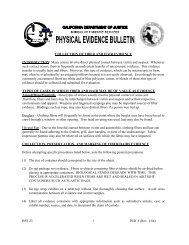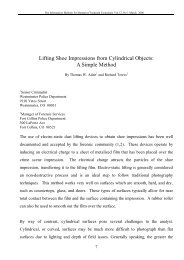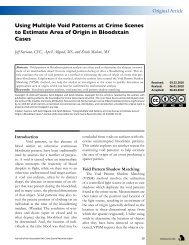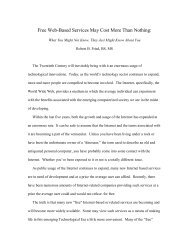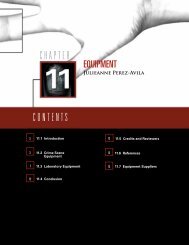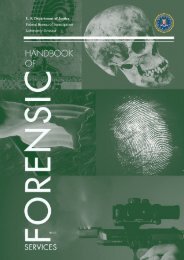PHYSICAL EVIDENCE MANUAL - Crime Scene Investigator Network
PHYSICAL EVIDENCE MANUAL - Crime Scene Investigator Network
PHYSICAL EVIDENCE MANUAL - Crime Scene Investigator Network
Create successful ePaper yourself
Turn your PDF publications into a flip-book with our unique Google optimized e-Paper software.
Physical Evidence Manual<br />
5.0 ARSON AND FIRE DEBRIS <strong>EVIDENCE</strong><br />
Many times it is difficult to ascertain whether a fire was accidental or arson. This<br />
is especially true when simple ignition devices such as a match and paper were<br />
used to start the fire. Frequently, flammable liquids such as gasoline, lighter fluid,<br />
fuel oil, etc. are used as accelerants. If a fire’s origin can be determined, it may<br />
be possible to detect and classify accelerants. Detection is not possible if the fire<br />
completely consumes the accelerant or if the samples are not from the fire’s<br />
origin. Because flammable liquids readily evaporate, care must be taken in the<br />
collection and packaging of fire debris. Containers of arson evidence need to be<br />
air tight to prevent loss by evaporation and possible contamination. Moisture is<br />
not a problem; do not dry arson evidence.<br />
Arson <strong>Scene</strong> Indicators<br />
• Multiple fires in unrelated areas of the fire scene<br />
• Odor of petroleum products, paint solvents, alcohol, etc.<br />
• Stains on floor or other material<br />
• Evidence of explosions not due to heat (shattered glass)<br />
• Rapid spread of fire not explainable by structure, weather, or other<br />
conditions<br />
• Smoke not explainable by building materials<br />
• Fire trails such as cloth or paper trails, burn trails on carpeting, or deep<br />
charring in hardwood<br />
• Removal of household property and valuable items<br />
• Evidence of another crime which the fire might conceal (items stolen,<br />
evidence of violence)<br />
• Recent similar fires in the vicinity<br />
Evidence To Collect<br />
• Charred debris and related material from the origin where the accelerant<br />
was placed<br />
• Igniting devices (fuses, rags, candles, etc.) including mechanical and<br />
electrical devices<br />
• Samples of upholstery, drywall, plaster, wood, or other material that may<br />
have been penetrated by flammable liquids<br />
• Samples of soil that may have been penetrated by flammable liquids<br />
• Trace evidence possibly left by the arsonist such as hairs, clothing fibers,<br />
matches, etc.<br />
• Suspect clothing worn at time of crime, including shoes<br />
• Liquids containing possible accelerants<br />
Adopted: May 2002<br />
Revisions: 6<br />
Last Revision: January 31, 2008<br />
5-1



